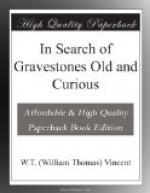[Illustration: Fig. 97. Neuhausen.]
In Neuhausen Graveyard, at the end of the row of graves, are seen two rings protruding from the ground. Lying near is an iron shield with two similar rings surmounting it. It is readily supposed that the first-named rings are also attached to a shield buried in the earth, and so it proves. In order that no space may be lost between the graves, the shields are used alternately to serve as the dividing wall, and are then drawn out, thus enabling the sexton to pack the coffins close together.
The towns and cities abroad have their cemeteries beyond the outskirts, as is the practice here. Occasionally an old churchyard is to be met with, but never an old gravestone as we know it. Still there are instances in which ancient carvings of the same character have been saved by attachment to the church or churchyard wall. Several such are to be seen in German churchyards long since converted to purposes of recreation, and one at Heidelberg may be taken as an example.
FIG. 98.—AT HEIDELBERG
To “Barbara Fosterii,” died 1745, aged 67.
Beneath is the text from the First Epistle of Peter, chapter i. verses 24 and 25.
“All flesh is as grass,
and all the glory of man as the flower
of grass. The grass withereth,
and the flower thereof falleth
away: but the Word of
the Lord endureth for ever.”
At Lucerne, tinder similar conditions, the striking figures of two skeletons, partly in military garb, keep guard over the tablet which records the virtues of a departed hero. He was probably a soldier, but the figure of a lictor on the left with his fasces of axe and rods seems to betoken some civil employment. In ancient times the lictors walked in advance of the magistrates, and executed sentence when pronounced.
[Illustration: FIG. 99. LUCERNE.]
[Illustration: FIG. 98. HEIDELBERG.]
FIG. 99.—AT LUCERNE.
To “Iodoco Bernardo Hartman,”
died 1752,
aged 67 years.
The two last-given illustrations may possibly belong to the category of mural tablets rather than that of gravestones, being fixed apparently by original design, and not by afterthought, as in our “converted” burial-grounds, against the outer walls of the church. There are, however, no other remains which I could discover bearing any resemblance to the old British headstone, and the evanescent character which seems to have attached for a certain period to the memorials of the dead among our neighbours abroad forbids the expectation that any such as those which have appeared in our earlier chapters are to be found in Europe outside the boundaries of our Empire. In more modern observances, especially in the centres of population, English and continental manners more nearly approximate; and in the many new cemeteries which are now to be found adjacent to the cities and large towns of Western Europe there are tombs and gravestones as many and as costly as are to be found in any round London. In Germany the present practice appears to be single interments, and one inscription only on the stone, and that studiously brief. Thus:




